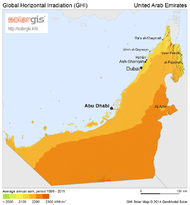Solar power in the United Arab Emirates

Solar power in the UAE (United Arab Emirates) has the potential to provide most of the country's electricity demand. While being a major oil producing country, the United Arab Emirates (UAE) has taken steps to introduce solar power on a large scale. However, solar power still accounts for a small share of energy production in the country. Until 2013, there was no operational solar power in the UAE.[1] The country was the 6th top carbon dioxide emitter per capita in the world in 2009, with 40.31 tonnes,[2] but is planning to generate the vast majority of its electrical energy by 2050 from solar and nuclear sources.
By region
Abu Dhabi
In 2013, the Shams solar power station, a 100-megawatt (MW) concentrated solar power (CSP) plant near Abu Dhabi became operational. The US$600 million Shams 1 is the largest CSP plant outside the United States and Spain and is expected to be followed by two more stations, Shams 2 and Shams 3.[3]
Masdar City in Abu Dhabi is designed to be the most environmentally sustainable city in the world. The city relies entirely on renewable energy. Power is generated by a 10 MW solar PV power plant located on site and 1 MW of rooftop solar panels. Originally planned to have all rooftop panels, it was found easier to clean the sand off ground mounted panels at a single location.[4]
Dubai
The Dubai Clean Energy Strategy aims to provide 7 per cent of Dubai’s energy from clean energy sources by 2020. It will increase this target to 25 per cent by 2030 and 75 per cent by 2050.[5] Due to a variety of factors, a Saudi-backed consortium had a low bid to build the solar farm in Dubai for only 3¢/kWh.[6]
The first phase of the proposed 1,000 MW Mohammed bin Rashid Al Maktoum Solar Park, in Seih Al-Dahal, about 50 kilometers south of the city of Dubai, was the 13-megawatt (DC) solar farm (DEWA 13) that had been constructed by First Solar in 2013.[7] It uses 152,880 FS-385 black CdTe modules and generates about 24 gigawatt-hours per year.[8][9] The second phase is a 200 MWAC (260 MWp[10]) photovoltaic plant to be built by ACWA Power, a Riyadh-based company, expected to be completed in April 2017.[11] The plant will also use First Solar's CdTe modules.[12] In April 2015, Dubai Electricity and Water Authority (DEWA) publicly announced the third phase of 800 MW, along with Dubai's revised target to increase the share of renewables on the energy mix to 7% by 2020.[13]
The Mohammed bin Rashid Al Maktoum Solar Park is one of the world's largest renewable project based on an independent power producer (IPP) model. Besides the three phases that consist of solar farms using PV technology, the long-term project will also include concentrating solar power (CSP). The total capacity of the entire project is planned to reach 3,000 MW.[13]
The 200-megawatt second phase of the project caused worldwide attention, as the winning bid of the tender set a new record-low tariff of only US ¢5.89 per kilowatt-hour. This is about 20% lower than any previous, unsubsidized power purchase agreement (PPA) the world has seen before. The PPA is set to a 25-year time frame.[10][14]
In parallel to the utility-scale projects of the Mohammed bin Rashid Al Maktoum Solar Park, in March 2015 DEWA also launched a net metering scheme to encourage companies and private individuals to install solar power on their roofs.[15] While the scheme is currently voluntary, solar panels are to be made mandatory for all buildings in Dubai by 2030.[16]
See also
External links
- Interview on YouTube – Michael Liebreich, "Cheapest Solar in World", about the record-low 5.84 US cents/kWh PPA in Dubai
- Solar Energy in Dubai, Mohammed bin Rashid Al Maktoum Solar Park, DEWA, Government of Dubai
References
- ↑ "IEA - Report". www.iea.org. IEA. Retrieved 15 June 2016.
- ↑ World carbon dioxide emissions data by country: China speeds ahead of the rest Guardian 31 January 2011
- ↑ shamspower.ae Shames-website
- ↑ Masdar: the shifting goalposts of Abu Dhabi's ambitious eco-city, Wired, 17 December 2013
- ↑ http://www.thenational.ae/business/energy/dubai-ruler-wants-solar-panels-on-every-roof-by-2030
- ↑ Beyond Climate Confusion: Why Both Energy Innovation and Deployment Matter Varun Sivaram Council on Foreign Relations May 4, 2016
- ↑ STATE OF REPORT: Dubai 2014, United Nations Development Programme, ISBN 978-9948-20-456-5 (Note: In the original document, the ISBN is printed as "5-456-20-9948-978", which reads right to left.)
- ↑ DEWA 13 Solar Plant, First Solar
- ↑ FirstSolar Factsheet, PDF
- 1 2 http://ameinfo.com/ ACWA Power wins 200 megawatts (260MWp) phase II Mohammed bin Rashid Solar Park by Dubai Electricity and Water Authority, 17 January 2015
- ↑ Dubai Doubles Power-Plant Size to Make Cheapest Solar Energy, Bloomberg, Anthony DiPaola, January 15, 2015
- ↑ "First Solar Modules to Power Landmark 200MW Solar Photovoltaic Project in Dubai". MarketWatch. 23 June 2015.
- 1 2 SolarServer.com DEWA announces 800 MW third Phase of the Mohammed bin Rashid Al Maktoum Solar Park, 21 April 2015
- ↑ Craig Morris (27 November 2014). "Solar in Dubai reaches record low price". RenewablesInternational.net.
- ↑ "DEWA announces Shams Dubai to regulate generation of solar energy in buildings and connection to its grid". WAM Emirates New Agency. 15 March 2015. Retrieved 14 February 2016.
- ↑ "Solar panels on all Dubai roofs by 2030". Khaleej Times. 29 November 2015. Retrieved 14 February 2016.